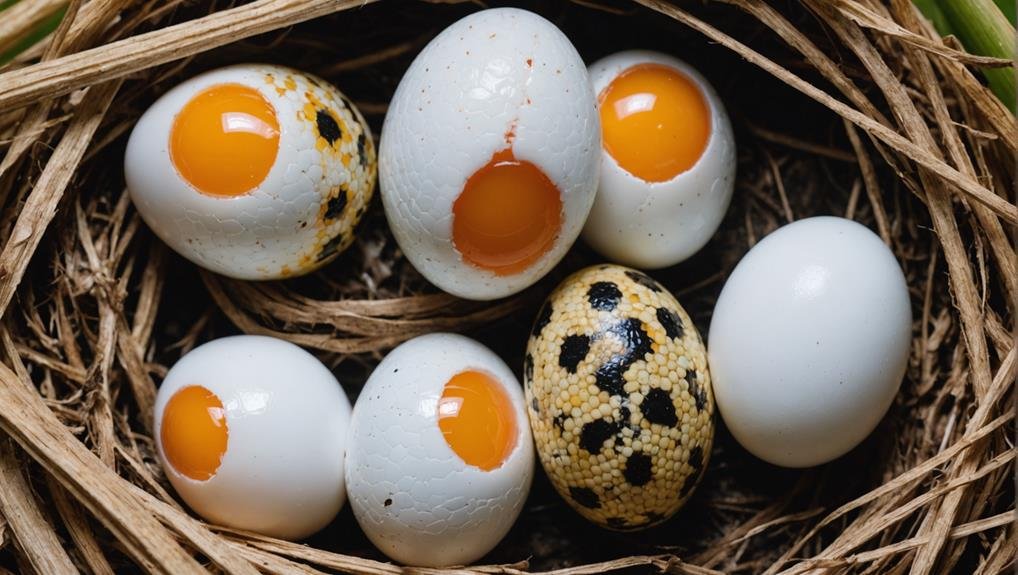When incubating corn snake eggs, spotting signs of unhealthiness early on is crucial. For example, a lack of visible veins could indicate developmental issues, as healthy eggs typically have well-defined veins. A foul smell might indicate bacterial or fungal contamination, necessitating immediate isolation and proper ventilation. Discoloration, a soft consistency, or abnormalities also raise concerns. Mold presence is particularly problematic. So, how can you guarantee the viability and health of your corn snake eggs throughout the incubation period? Let’s explore what you must watch out for and what steps to take next.
Key Takeaways
- Lack of visible veins indicates developmental issues.
- A foul odor suggests bacterial or fungal contamination.
- Significant discoloration, especially yellowing, signals potential viability problems.
- The overly soft texture of the egg points to poor health and inadequate gas exchange.
- The presence of mold on eggs requires immediate attention to prevent further complications.
Lack of Visible Veins
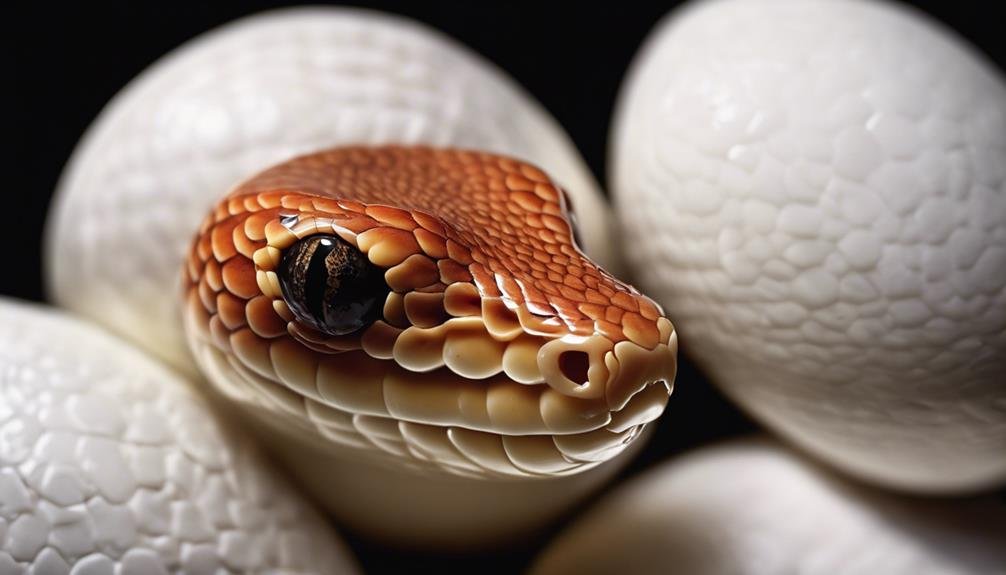

You might notice a lack of visible veins when candling corn snake eggs, indicating potential developmental issues. Healthy corn snake eggs display well-defined veins when illuminated, indicating proper growth and viability. If you don’t see these veins, it’s a red flag that the egg may not develop as it should.
Candling involves shining a light through the egg to observe its interior. This simple yet effective technique helps you assess the health of your corn snake eggs. When you shine the light, healthy eggs reveal a network of veins, a sign that the embryo is receiving adequate nutrients and developing correctly. The absence of veins suggests that the egg mightn’t be viable.
It’s vital to act on these observations. Consulting with experienced breeders or herpetologists can offer additional insights if you’re unsure about what you see. They can help you interpret the results more accurately and advise on the best action. Regularly candling your corn snake eggs and looking for those critical veins can make a significant difference in ensuring the health of your future hatchlings.
Foul Odor
If you notice a foul odor coming from a corn snake egg, it’s a clear sign of bacterial or fungal contamination. This musty, rancid, or putrid smell indicates that the egg is likely no longer viable. To manage this issue, isolate the affected egg immediately to protect the rest of the clutch.
Identifying Rotten Egg Smells
A foul odor is a sure sign of an unhealthy cornsnake egg. When caring for corn snake eggs, distinguishing good from bad eggs is vital; the smell can be your first clue.
Rotten eggs emit a putrid or sulfuric smell due to bacterial growth. This odor is unmistakable and serves as a clear indicator that the egg is spoiling and the developing embryo is at risk.
If you detect a strong, unpleasant smell from any of the eggs, it’s likely unhealthy and should be promptly removed. Leaving a rotten egg in the clutch can lead to contamination, jeopardizing the health of the remaining good eggs.
Regular checks and proper ventilation are necessary to monitor your eggs to help spot any issues early.
Managing Egg Odor Issues
Detecting a foul odor from your corn snake eggs isn’t just unpleasant; it likely signals bacterial or fungal contamination. This could mean the eggs are decaying or simply not viable. To tackle this, focus on odor prevention by ensuring proper ventilation and humidity control in your incubation setup.
Good ventilation tips include:
- Using an incubator with adjustable air vents
- Using a small fan to promote airflow
This helps keep the environment fresh and less conducive to mold and bacterial growth.
Closely monitor the humidity levels, as excessive moisture can foster fungal contamination. Aim for balanced humidity that supports healthy egg development without creating a breeding ground for pathogens. If you notice any visibly contaminated eggs or emitting a foul smell, remove them immediately to prevent potential issues from spreading to the healthier eggs.
If foul odors persist despite your efforts, don’t hesitate to seek advice from experienced breeders or reptile veterinarians. They can provide valuable insights into incubation troubleshooting and help you identify and solve underlying problems. These steps will create a healthier incubation environment, increasing the chances of successful hatching.
Significant Discoloration
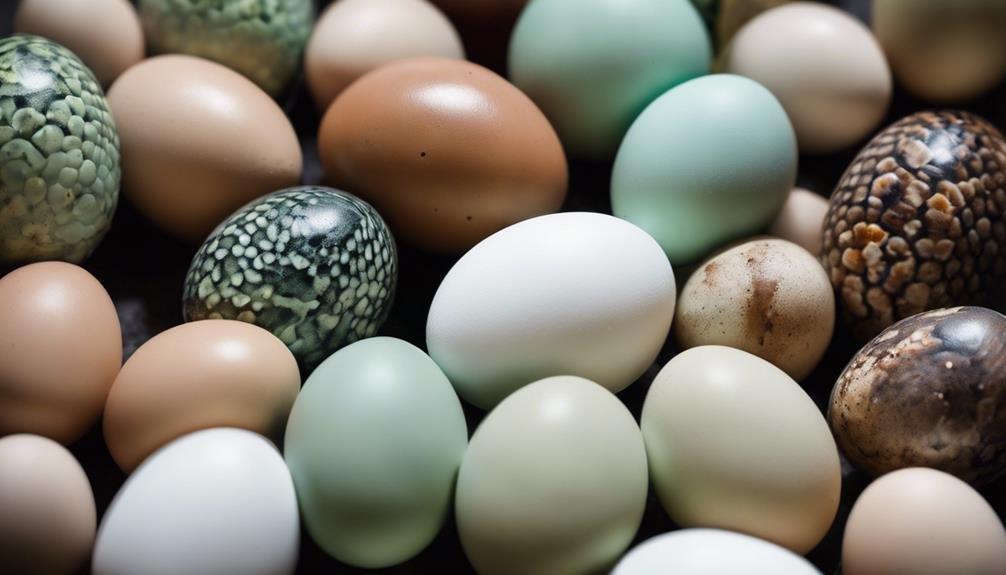

Significant hue change in corn snake eggs often indicates potential viability issues. You might notice hue change patterns such as yellow, brown, or dark spots on the eggshell. These patterns are key indicators of eggshell abnormalities and shouldn’t be overlooked.
When evaluating the viability of your corn snake eggs, please pay close attention to these hue change patterns, as they can reveal underlying health problems.
Mold growth is another factor contributing to hue change. Spotting mold on the eggs is a clear sign that the eggs might be compromised. Eggs with altered color usually have a lower chance of hatching successfully, so monitoring them closely is essential.
You’ll want to check the eggs periodically for color changes to catch any issues early.
Regular viability evaluation is essential. When you notice a significant hue change, it’s a red flag that warrants immediate attention. By watching eggshell abnormalities and hue change patterns, you can better gauge the health of your corn snake eggs.
This proactive approach can help you determine whether the eggs are likely to hatch or if they require intervention to improve their chances of survival.
Overly Soft Texture
When you notice an overly soft texture in a corn snake egg, it indicates poor health. This squishiness might mean the egg has weak structural integrity, often due to moisture issues or a lack of calcium. Look for mold, which can further soften the egg and signal a potential fungal infection.
Indicators of Poor Health
Many unhealthy corn snake eggs exhibit an overly soft consistency, feeling mushy. This softness can signal significant issues with the egg’s overall well-being. An excessively soft consistency can hinder proper gas exchange, which is essential for embryo development. The embryo may struggle to thrive without adequate gas exchange, leading to further complications.
Soft eggs often indicate nutrient deficiencies, which directly impact egg health. Nutrients like calcium are vital for forming a strong, sturdy eggshell. When these nutrients are lacking, the eggshell becomes soft, jeopardizing the embryo’s environment and increasing the risk of developmental problems.
To ensure you’re on top of your corn snake eggs’ health, you must regularly monitor their consistency. Here’s a simple three-step process to help you with viability assessment and monitoring techniques:
- Visual Inspection: Regularly check the eggs for any changes in appearance, such as discoloration or deformation.
- Physical Examination: Gently touch the eggs to gauge their consistency, ensuring they’re not overly soft or mushy.
- Nutrient Analysis: Confirm the breeding environment provides all necessary nutrients, particularly calcium, to maintain eggshell integrity.
Egg Structural Weakness
You might notice an unhealthy corn snake egg feeling squishy or easily deformed when touching it. This overly soft texture is a clear sign of structural fragility, which could indicate developmental issues or support worries for the growing embryo. If the egg lacks the necessary firmness, the embryo mightn’t have the stability it needs to develop properly, increasing the risk of deformities.
Structural fragility in corn snake eggs often points to incubation problems. Improper humidity or temperature levels during incubation can cause the eggs to become too soft. These suboptimal conditions can lead to failed hatching, as the embryo may not survive in the compromised environment. Ensuring the right incubation conditions is essential for maintaining egg health and supporting successful development.
If you observe that the eggs are overly soft, prompt attention is needed. Addressing these concerns quickly can improve the chances of a successful hatching. You might need to adjust your incubator’s humidity and temperature settings to create a more suitable environment. By monitoring and correcting these factors, you can reduce the risk of deformities and promote the health of the developing embryos.
Strange Egg Shapes
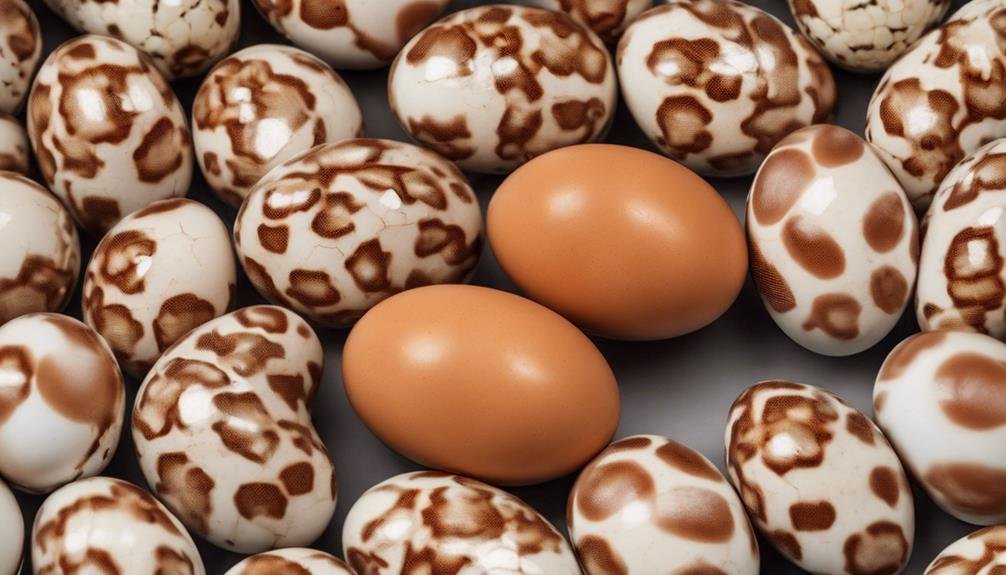

Strange egg forms in corn snake clutches can indicate potential developmental issues or compromised viability early. You might notice some eggs folded in or irregularly shaped. These egg deformities can stem from several possible causes, including genetic factors, environmental stress, or improper incubation conditions. When eggs aren’t oval or round, it can be a red flag signaling underlying problems that could affect the entire clutch.
The impact on hatchling health can be significant. Irregularly shaped eggs often lead to poor development or even failure to hatch. Even if a hatchling emerges, it might suffer from health issues that can compromise its survival and growth. Hence, closely monitoring egg shapes is essential to catch any abnormalities early.
Preventing abnormal shapes involves taking proactive steps to maintain ideal conditions for corn snake eggs. Here are three key actions you can take:
- Sustain proper temperature and humidity levels to reduce stress on the eggs.
- Ensure genetic variety by carefully selecting breeding pairs to minimize hereditary deformities.
- Regularly examine the eggs during incubation to address any irregularities promptly.
Presence of Mold
Mold on corn snake eggs is a clear sign of potential trouble. It often indicates a fungal or bacterial infection that threatens egg viability. Acting quickly is vital if you spot blue or green mold on your eggs. Mold can grow due to excessive moisture or poor ventilation, compromising the chances of a successful hatch.
One of the first steps in addressing this issue is to remove the mold. You can use mold removal techniques such as gently wiping the affected area with a damp cloth or using a mild antiseptic solution. Be careful not to damage the egg’s surface.
Next, focus on prevention. Improving the incubation environment is key. Ensure proper ventilation and maintain ideal humidity levels to prevent mold growth. Excessive moisture often leads to decreased oxygen exchange, greatly impacting embryo development. Keeping the incubation environment well-regulated helps protect the eggs from mold and the associated risks.
Check the eggs regularly for signs of mold and make adjustments as needed. These proactive steps can significantly improve the health and viability of your corn snake eggs, ultimately leading to a higher success rate in hatching.
Yellow Coloration
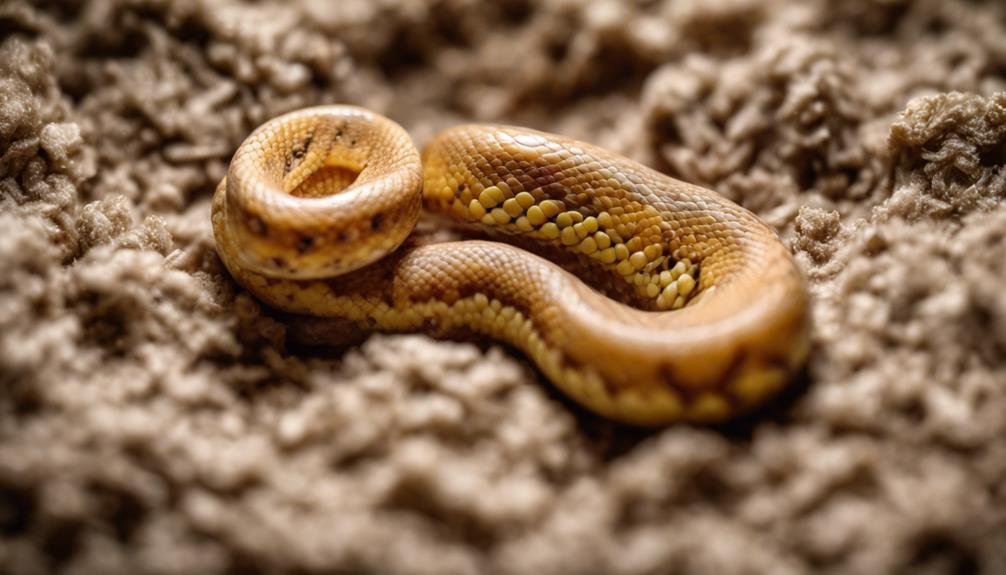

While monitoring the health of corn snake eggs, pay close attention to any yellow coloration that appears. This yellowing can be a significant indicator during your egg health assessment. Eggs with an unusual or intense yellow color may signal potential issues, such as bacterial or fungal growth. It’s essential to differentiate between a healthy yellow tint and problematic discoloration to secure the viability of your eggs.
To assess the yellow coloration effectively, consider these key points:
- Normal vs. Abnormal Yellow Tint: A slight yellow tint can be typical, but if you notice a sudden change to a more intense yellow, it could indicate problems.
- Bacterial and Fungal Growth: Unusual yellowing often indicates bacterial or fungal contamination. This can compromise the egg and potentially lead to developmental abnormalities.
- Seek Expert Advice: If you’re unsure about the significance of yellow coloration, consult experienced breeders or herpetologists. They can provide valuable insights and recommendations for addressing potential issues.
Small Egg Size
A small egg size in corn snakes can indicate potential issues with the embryo’s development and health. When you notice smaller-than-average eggs, it might suggest underdevelopment or improper nutrition during egg formation. These smaller eggs can also have structural or genetic abnormalities, lowering their chances of successful hatching.
To manage this, you must closely monitor small eggs’ growth and condition. Make sure your incubation methods are spot-on. Proper egg rotation prevents the embryo from adhering to the eggshell. Additionally, focus on maintaining ideal temperature regulation and humidity levels. These environmental factors greatly impact embryo development.
Breeding pairs play a vital role, too. Genetic factors might contribute to the small size of the eggs. Discussing your observations with experienced breeders or consulting a reptile veterinarian can provide valuable insights and recommendations.
Here’s a quick reference table for managing small corn snake eggs:
| Factor | Key Considerations | Actions to Take |
|---|---|---|
| Incubation Methods | Proper egg rotation | Rotate eggs gently and regularly |
| Temperature Regulation | Maintain consistent temperature | Use reliable thermometers |
| Breeding Pairs | Genetic factors | Evaluate and select healthy pairs |
Testing Egg Viability
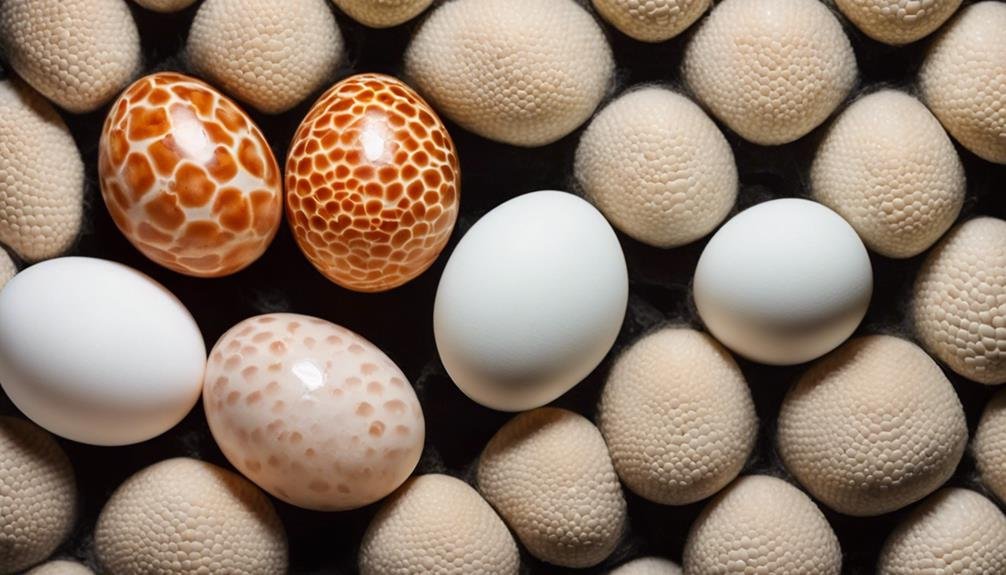

Testing egg viability is necessary to ensure corn snake eggs’ health and successful hatching. One simple yet effective method is the water absorption test. Here’s how you can do it:
- Lightly spray the eggs: Gently mist the eggs with water to evaluate their egg moisture levels. Healthy eggs will show signs of absorbing the water, making them appear more swollen.
- Observe absorption: Good eggs will soak up the moisture, while non-viable eggs, often called slugs, typically won’t. This difference is vital for your viability evaluation.
- Check for improvements: After misting, closely monitor the eggs. Healthy egg indicators include becoming rounder and more solid, indicating they’ve absorbed the moisture.
The eggs may be considered non-viable if they don’t absorb water or show signs of remaining dry and shriveled. This method helps identify which eggs are likely to hatch successfully and which ones mightn’t. Conducting this simple test can be an important step in evaluating your corn snake eggs’ health and potential viability, ensuring that you provide the best care for the developing embryos.
Conclusion
Take immediate action if you spot any of these signs—no visible veins, foul odors, discoloration, softness, odd shapes, mold, yellowing, or small size. Isolate the problematic eggs, consult experienced breeders, and maximize incubation conditions. By staying vigilant and proactive, you’ll increase the chances of hatching healthy corn snakes. Don’t hesitate to intervene when necessary; your prompt response can make all the difference in the health and viability of your corn snake eggs.
FAQs
1. How to Tell if a Snake Egg Is Bad?
To tell if a snake egg is bad, check the egg coloration for any discolorations, feel the egg texture to see if it’s squishy or deflated, and sniff the egg smell for any foul odors. Trust your observations.
2. What Do Healthy Snake Eggs Look Like?
You’ll find healthy snake eggs are plump and smooth with a firm texture. During egg candling, look for visible veins. Guarantee proper egg turning and maintain correct egg incubation temperature to keep them viable and developing well.
3. How to Tell if Corn Snake Eggs Are Fertile?
To tell if corn snake eggs are fertile, use egg candling to check for visible veins and movement. Egg floating can also help assess viability. Observe egg development stages by monitoring color consistency and firmness throughout incubation.
4. How to Tell if a Corn Snake Is Egg-Bound?
You can spot egg-bound symptoms like a swollen abdomen and distress. Treatment options include manual extraction, hormone therapy, or surgery. Prevent egg-binding by providing proper nesting sites and closely monitoring your snake’s health during breeding seasons.

